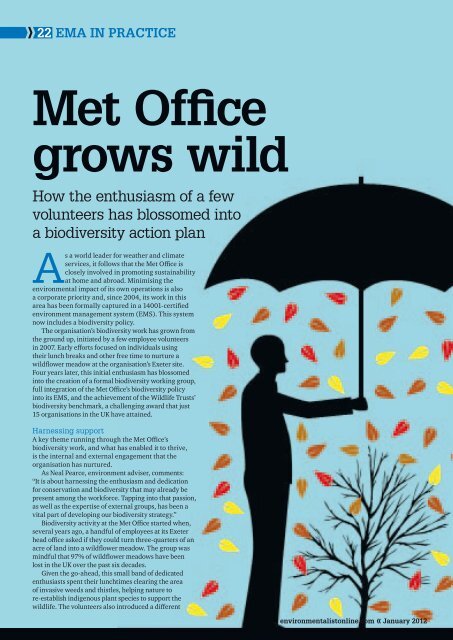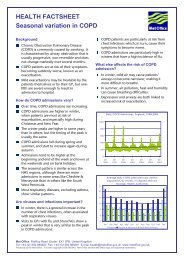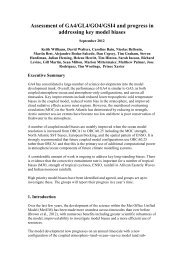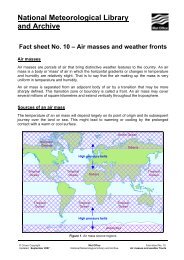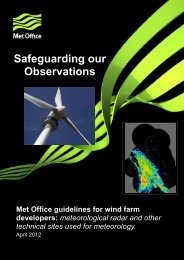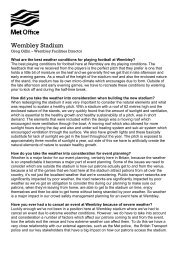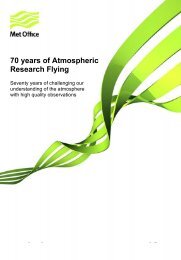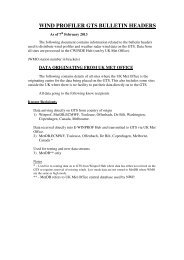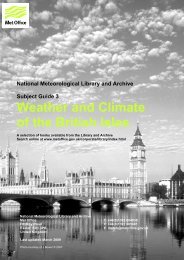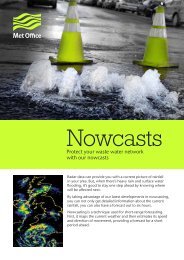Environmentalist article (PDF, 981 kB) - Met Office
Environmentalist article (PDF, 981 kB) - Met Office
Environmentalist article (PDF, 981 kB) - Met Office
- No tags were found...
Create successful ePaper yourself
Turn your PDF publications into a flip-book with our unique Google optimized e-Paper software.
22EMA IN PRACTICE<strong>Met</strong> <strong>Office</strong>grows wildHow the enthusiasm of a fewvolunteers has blossomed intoa biodiversity action planAs a world leader for weather and climateservices, it follows that the <strong>Met</strong> <strong>Office</strong> isclosely involved in promoting sustainabilityat home and abroad. Minimising theenvironmental impact of its own operations is alsoa corporate priority and, since 2004, its work in thisarea has been formally captured in a 14001-certifiedenvironment management system (EMS). This systemnow includes a biodiversity policy.The organisation’s biodiversity work has grown fromthe ground up, initiated by a few employee volunteersin 2007. Early efforts focused on individuals usingtheir lunch breaks and other free time to nurture awildflower meadow at the organisation’s Exeter site.Four years later, this initial enthusiasm has blossomedinto the creation of a formal biodiversity working group,full integration of the <strong>Met</strong> <strong>Office</strong>’s biodiversity policyinto its EMS, and the achievement of the Wildlife Trusts’biodiversity benchmark, a challenging award that just15 organisations in the UK have attained.Harnessing supportA key theme running through the <strong>Met</strong> <strong>Office</strong>’sbiodiversity work, and what has enabled it to thrive,is the internal and external engagement that theorganisation has nurtured.As Neal Pearce, environment adviser, comments:“It is about harnessing the enthusiasm and dedicationfor conservation and biodiversity that may already bepresent among the workforce. Tapping into that passion,as well as the expertise of external groups, has been avital part of developing our biodiversity strategy.”Biodiversity activity at the <strong>Met</strong> <strong>Office</strong> started when,several years ago, a handful of employees at its Exeterhead office asked if they could turn three-quarters of anacre of land into a wildflower meadow. The group wasmindful that 97% of wildflower meadows have beenlost in the UK over the past six decades.Given the go-ahead, this small band of dedicatedenthusiasts spent their lunchtimes clearing the areaof invasive weeds and thistles, helping nature tore-establish indigenous plant species to support thewildlife. The volunteers also introduced a differentenvironmentalistonline.com « January 2012
EMA IN PRACTICE 23mowing regime, giving the wildflowers a chance togrow, flower and seed.Even simple steps such as no longer applyingfertiliser can have a significant impact on biodiversity,reveals Pearce. In the <strong>Met</strong> <strong>Office</strong>’s meadow, fertiliserhad drained into the ponds, increasing the nitratecontent in the water. Halting its use has improved thewater quality, and planting water lilies has reducedthe growth of algae, encouraging the establishment ofcolonies of amphibians. Mowing less frequently in thetwo metres around the pond has also led to an increasein the number of damp-meadow wild plants growingnearby, including the very rare maiden pink.The initial voluntary work started to attractinterest from other employees who, it turned out,had considerable knowledge of a variety of nicheconservation areas. For example, one of the chiefforecasters contacted the environment team to offer hisassistance. He had an extensive knowledge of bats, andhe undertook an on-site study of the mammals usinga passive audio recorder at four different locations tocover the spread of habitats.His research identified 10 bat species, including therare barbastelle and greater horseshoe bats, as well asthree other species now identified in the organisation’sbiodiversity action plan. The results were shared withexternal bodies, including the RSPB.It also turned out that the <strong>Met</strong> <strong>Office</strong> had a residentbird watcher working in the Exeter office, who has nowidentified 53 different bird species in the meadow sincethe project began, and another employee came forwardwith knowledge of ponds.“We were able to tap into what people were doing intheir own time and use their passion and knowledge toexpand our biodiversity work,” says Pearce. “It wouldnot have worked if we had taken a top-down approachand imposed these projects on people, we needed tobuild it from the bottom up.” This process of employeeengagement is self-perpetuating and creates its ownmomentum, according to Pearce.Coming togetherThe <strong>Met</strong> <strong>Office</strong> added a degree of structure to thisactivity on the ground by setting up a biodiversitygroup in 2010. Meeting regularly, the group is chairedby one of the early enthusiasts and works closely withcolleagues in property management.The existence of the group has helped to acceleratethe active management of biodiversity and its ideas havealready led to improvements including the modifiedmowing regimes, “under planting” with wildflowersrather than bark, log piles in wooded areas to encouragecreature habitats, and garden markers highlighting rarewild orchids and “work in progress”.In its very early stages, there was concern aboutextending the wildflower meadow project, says Pearce,with some employees thinking it might result in thesite “looking untidy”. That view has now changedconsiderably with many staff, if not actively joining inthe biodiversity work, enjoying its benefits by choosingto eat their lunch on some of the benches that have nowbeen placed in the meadow.The wildflower meadow atthe <strong>Met</strong> <strong>Office</strong>’s Exeter HQOne initiative that has really inspired widespreadinterest this year is the installation of beehives on-site,with the support of the Exeter Beekeepers’ Association.So far, these hives have produced 30lb of good-qualityhoney that was jarred, labelled as “<strong>Met</strong> <strong>Office</strong> Honey”,and offered on sale to staff.This approach further engaged employees andgenerated a lot of internal interest in the subject, withsubsequent talks to staff by the beekeepers being“packed out”, says Pearce.Going outsideOnce the <strong>Met</strong> <strong>Office</strong>’s biodiversity agenda beganto gain momentum and purpose, the organisationwanted to find a way to demonstrate its compliancewith national and local priorities in the area, andhave its work formally recognised. It applied for andbecame one of only a handful of organisations toachieve the Wildlife Trusts’ biodiversity benchmarkaward. Only 15 organisations and 40 sites in the UKhave met this rigorous standard, and the <strong>Met</strong> <strong>Office</strong>was the first from the public sector.The Wildlife Trusts says that its benchmark cancomplement existing EMSs by integrating biodiversityinto the systems of an organisation, and this is exactlywhat the <strong>Met</strong> <strong>Office</strong> has done.“We have fully assimilated the biodiversitybenchmark clause requirements into our EMS, as therewas no point in duplicating operational procedures,”explains Pearce. “It is important that we streamline ourprocesses and management systems to make them asaccessible and easy to use as possible.”The <strong>Met</strong> <strong>Office</strong>’s collaboration with the WildlifeTrusts has now moved up a level, with a closepartnership in the process of being formed to helpdeliver the trusts’ “Living landscapes” project. Thisis the Wildlife Trusts’ vision to create a network oflandscape-scale projects throughout the UK, restoringand re-creating wildlife-rich spaces.Given the <strong>Met</strong> <strong>Office</strong>’s unparalleled expertise on theweather and climate change, this collaboration has thepotential to be mutually beneficial, with the <strong>Met</strong> <strong>Office</strong>’sgrowing work on biodiversity continuing to benefit fromJanuary 2012 » environmentalistonline.com
24EMA IN PRACTICEWORKING IN PARTNERSHIPEngaging with external interested partners such as the Wildlife Trustsis key to effectively implementing a biodiversity strategy, says NealPearce, environment adviser at the <strong>Met</strong> <strong>Office</strong>.This external engagement works on a number of different levels. Onone level, it is invaluable to tap into the expertise that already exists ona national, regional and local level. This is why the <strong>Met</strong> <strong>Office</strong> engageswith a wide variety of wildlife charities and bodies, ranging from theRSPB to the British Dragonfly Society.Typically, these niche wildlife organisations are a font of specialistinformation. They are passionate about their area of expertise and morethan happy to share their knowledge. “You will find that you are pushingat an open door,” comments Pearce. “Nearly every organisation I havecontacted so far has been willing to engage and help.” Undertaking thistype of stakeholder engagement can always bring benefits in terms ofknowledge transfer, both big and small, he says.On another level, engagement with external parties can help toresolve perceived barriers to biodiversity enhancement. For example,as part of its strategy to support the RSPB and Exeter City Council’sencouragement of habitats for swifts, the <strong>Met</strong> <strong>Office</strong> has installedsuitable nesting boxes at its Exeter head office. Initially there were someconcerns that the encouragement of additional bird activity could posea problem to Exeter City Airport, which operates nearby the site. Butby exploring the issue and through fully engaging with all interestedparties, including the Civil Aviation Authority, the <strong>Met</strong> <strong>Office</strong> gainedapproval for the project.It is also vital, adds Pearce, to find out what active biodiversitymanagement is already going on in the adjoining areas to capitaliseon the work already achieved and to assist in the creation of “wildlifecorridors”. It also means taking into account any localised sites ofsignificance, including designated Sites of Special Scientific Interest, andto assess the potential for supporting existing national, regional or localbiodiversity action plans.Access to East Devon County Council’s biodiversity action plan, forexample, meant Pearce discovered that the common primrose (primarosa) is valued in the county, from the perspective of being an “indicator”species and as an early season pollinator for invertebrates.Such awareness can ensure that planting strategies can be adapted togenerate suitable habitats, including identified supportive species, whichsubsequently can assist targeted wildlife.A further land holding under proactive development includes a threehectaresite located near Taunton, which turned out to be set on ancientwoodland. By making enquiries with the Forestry Commission andExmoor National Park, the <strong>Met</strong> <strong>Office</strong> has discovered that work can besupported to reinstate native broadleaf trees.Aside from its high-level partnership working with the WildlifeTrusts, the <strong>Met</strong> <strong>Office</strong> works on a local or regional level with some of the47 individual wildlife trusts across the UK that make up the nationalWildlife Trusts.the Wildlife Trusts’ extensive expertise in this area.Under the draft strategy currently being considered,the Wildlife Trusts will offer advice and guidance forbiodiversity enhancement at the <strong>Met</strong> <strong>Office</strong>’s head-officesite, while the <strong>Met</strong> <strong>Office</strong> will provide valuable adviceon factors, such as climate impact, which will affect thetrusts’ long-term strategy for living-landscape projects.Following the success of its work with the WildlifeTrusts, the <strong>Met</strong> <strong>Office</strong> has developed partnerships withother bodies (see panel, above).Common blue butterfliesinhabit the <strong>Met</strong> <strong>Office</strong> siteExpanding biodiversity reachThe geographical reach of the <strong>Met</strong> <strong>Office</strong>’s biodiversitywork has also flourished. As well as expanding at thehead-office site itself, where active biodiversity landmanagement now encapsulates the entire 10-hectaregrounds, the <strong>Met</strong> <strong>Office</strong>’s proactive biodiversitymanagement now extends across the UK on siteswhere it has land management responsibility. Forexample, developing biodiversity managementincorporates a weather balloon launch site in Cornwalland a 35-acre site in Bedfordshire that hosts a pair ofnesting peregrine falcons.The formalisation of the <strong>Met</strong> <strong>Office</strong>’s biodiversityinitiatives into a biodiversity action plan (BAP) hasenabled it to be more targeted in its work. The BAP’sbroad objectives include:• increasing biodiversity performance on assignedflower-rich meadows;• generating increased habitats within wooded areasto improve biodiversity performance;• improving wetland habitat in on-site ponds andadjoining land to encourage diversity;• monitoring biodiversity performance and reportingfindings; and• raising awareness and understanding ofbiodiversity issues among staff.The BAP has enabled the <strong>Met</strong> <strong>Office</strong> to encouragethe conservation of certain rare species or “species ofprincipal importance in England”, such as the songthrush, the brown hare and the cirl bunting. It alsokeeps a record of all biodiversity observations, withmore than 160 different species of amphibian, butterfly,bee, moth, plant, insect, bat, bird and mammal recordedon-site at Exeter so far.Implementing a far-reaching strategy for biodiversityhas been a sharp learning curve for Pearce and histeam at the <strong>Met</strong> <strong>Office</strong>. He warns that it is a mistake todevelop biodiversity in isolation. “Engage with others,”he advises. “You will not have to scratch the surface toodeeply before you find an abundance of knowledge andsupport both inside and outside the organisation.”environmentalistonline.com « January 2012


